November is prime for planting spring and summer-flowering bulbs, and with some planning now, exquisite container combinations bring new life as temperatures warm. From holiday displays and gifts (just around the corner) to welcoming spring, easy bulb-planting in the fall brings big rewards.
Bulbs are generous plants in their blooms and easy compatibility – they look great together and with other spring annuals and perennials. Their effortless grace complements any arrangement. Underplant your cool season annuals and containerized perennials for spring emergence. The design completely transforms as flowers emerge, and with little gardener effort. Tuck in a bunch now as hidden gems to enjoy later.
When pairing, be mindful of early, mid, and late-season bloomers to coordinate the combinations. With overlapping bloom times, you’ll have a lasting show of simultaneous color.
Blue Jacket Hyacinth
Blue Jacket Hyacinth Bulbs
Golden Dawn Daffodil
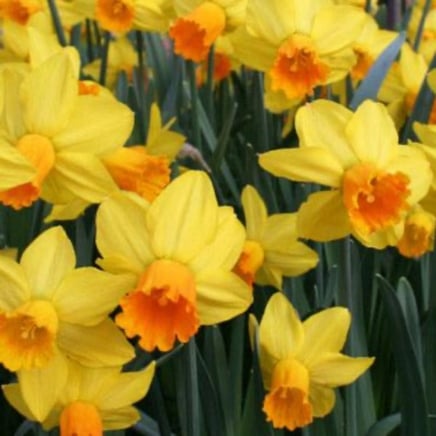
Golden Dawn Daffodil Bulbs
Orange Cassini Tulip
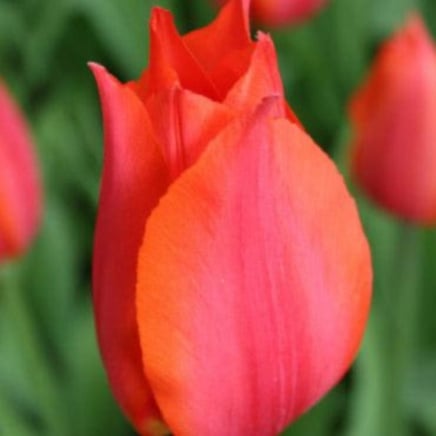
Orange Cassini Tulip Bulbs
Potting Notes
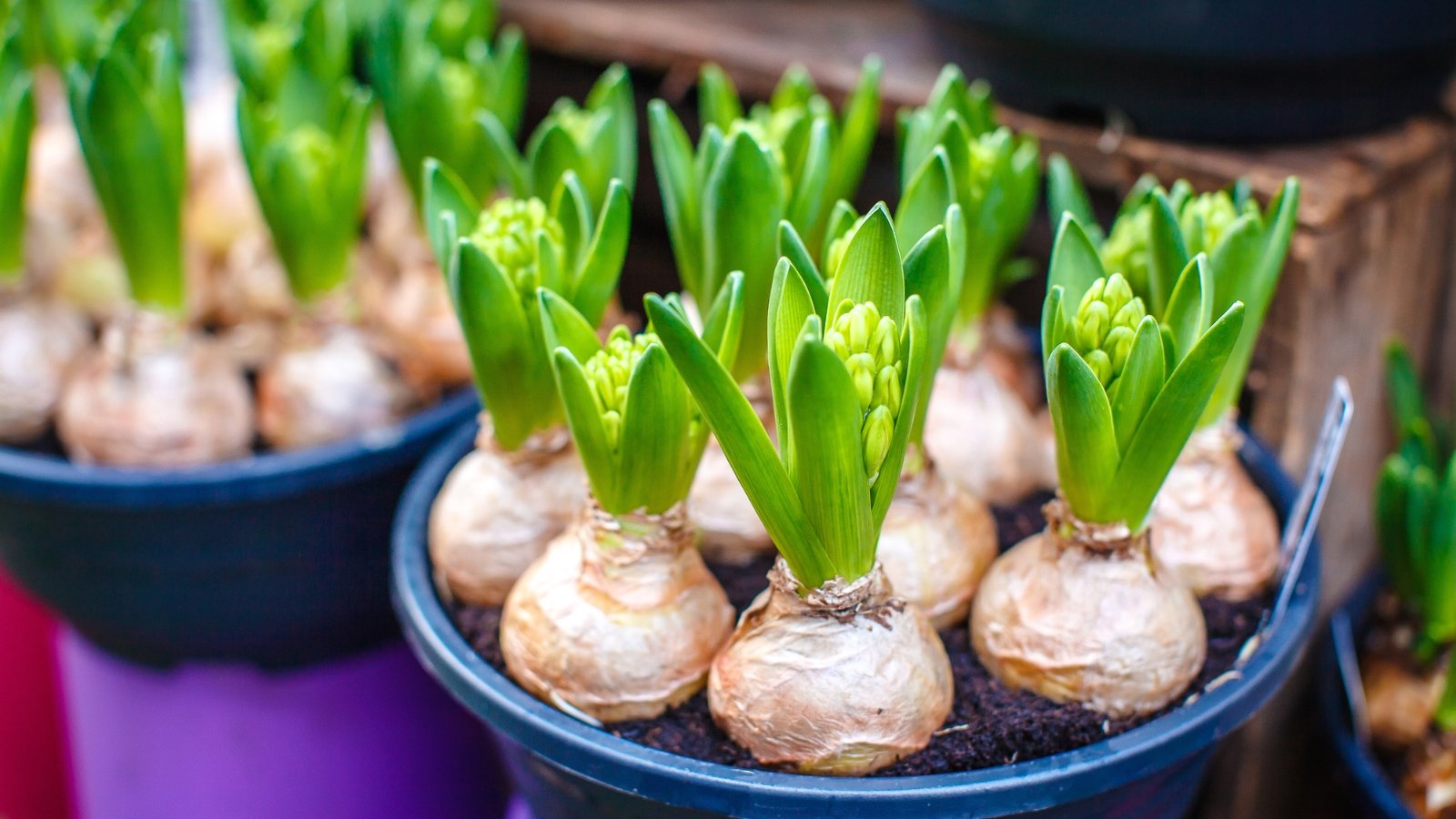
Start with a well-draining potting media in a container. Partially fill the pots with mix and place the bulbs according to their growing recommendations. Tuck the bulbs closely – nearer than inground spacing – for the best potted bulb design. Leave an inch or two of space beneath the pot’s rim before the soil level. Water well until it runs through the container and drainage hole.
For bulbs that need a winter chill period to grow (vernalization), place the pots outside this month. The fall placement assists with reaching cold temperatures of around 20°F (-7°C). An unheated cold frame or greenhouse works well, too. Nestle them close to a building or wall under a layer of leaves for insulation. Outdoors, they’ll receive adequate seasonal moisture without additional watering. If indoors or undercover, keep the soil moist but not waterlogged.
After about 10 to 12 weeks or as temperatures warm, uncover the containers and move them to their display location.
Forcing
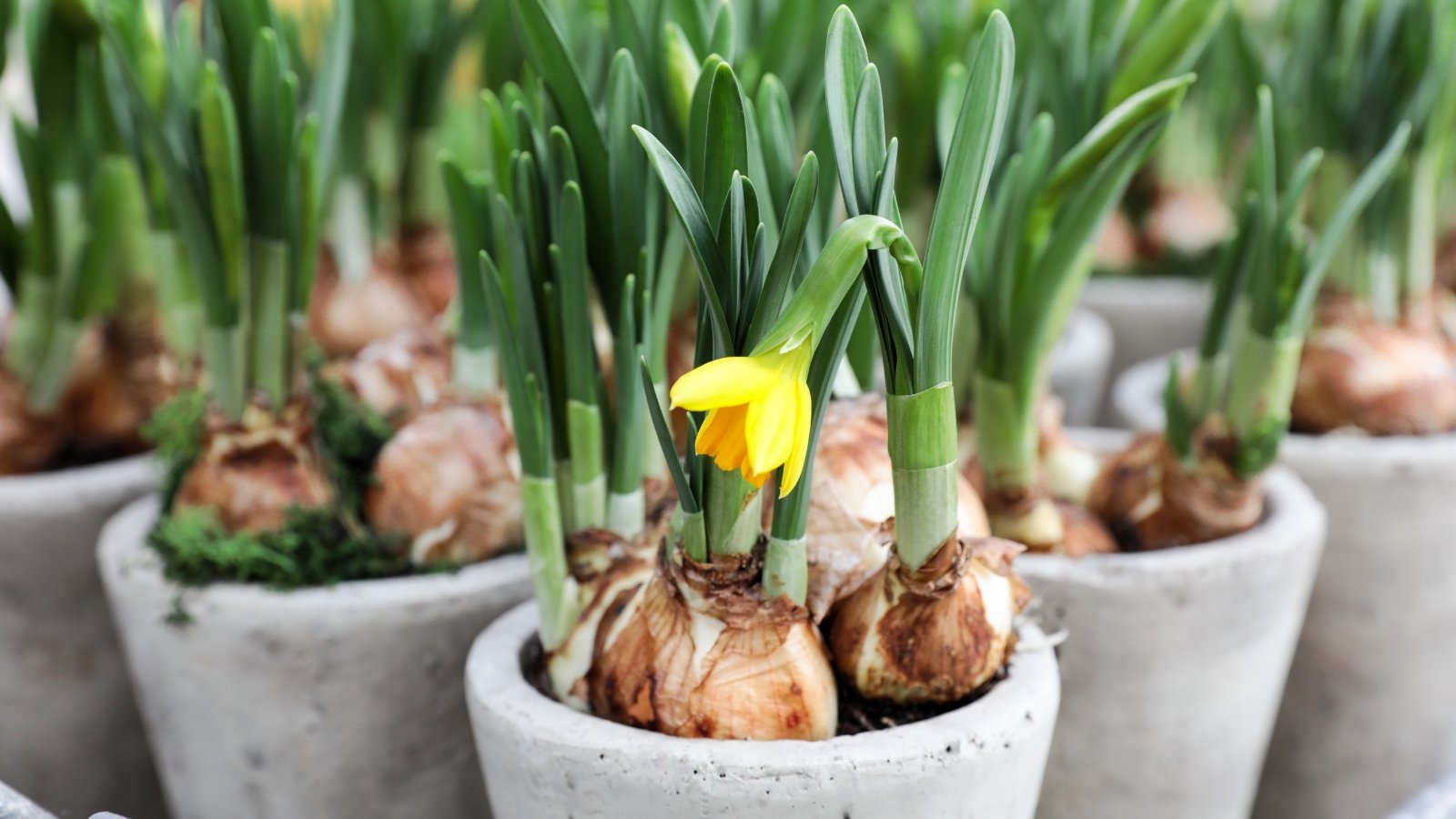
Many spring-flowering selections bloom indoors any time of year through forcing. You can force amaryllis, hyacinths, daffodils, tulips, and snowdrops into early flowering after adequate cold exposure. This makes for gorgeous holiday accents and natural gifts. Plant the bulbs in November for a holiday time display.
To make bulb growing easy, purchase pre-chilled bulbs. The grower exposes them to the necessary cool period, so leafing and budding happen quickly in warm conditions.
To prolong the interior display, keep the blooms out of direct sunlight and drafts from heater vents and fireplaces. It also helps to keep them cool at night.
Blue and Blush
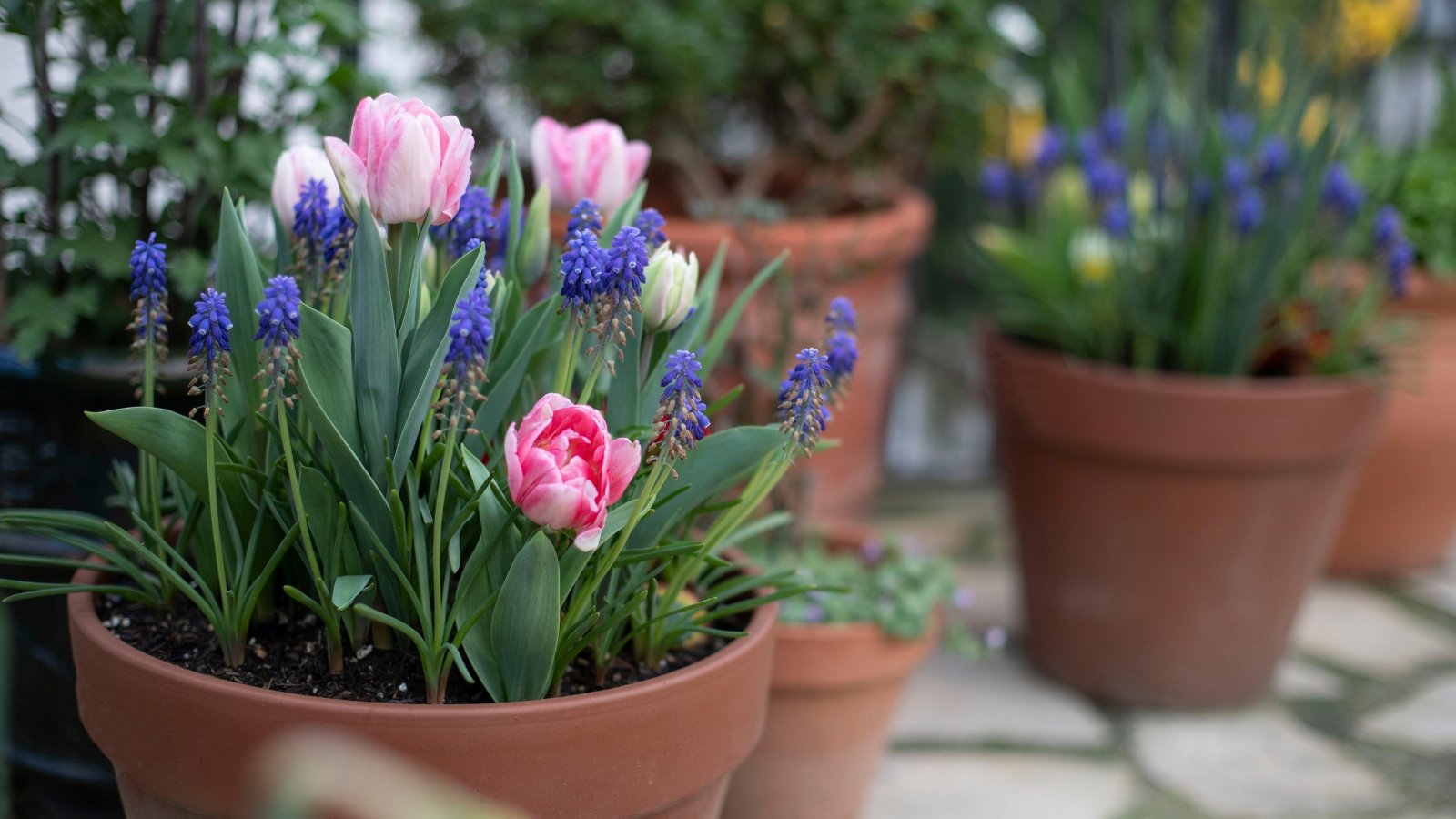
Grape hyacinth (Muscari armeniacum) is a star performer for its compact, colorful, and easy-growing qualities. It goes with just about any spring-flowering selection. The versatility and durability of the mid-late spring bloomer earned it the Royal Horticultural Society Award of Garden Merit. Tidy clusters of cobalt florets line compact stems, with cultivars in pink, purple, sky blue, and white.
Pale pink tulips offer a pastel blend among the rich blues. Look for Tulipa ‘China Town,’ a long-blooming Viridiflora type with pretty pale pink petals with a moss green streak. The foliage has creamy margins that highlight the cupped petals. Its unique markings and strong performance earned it Award of Garden Merit status, too.
Miniature Daffodil Ensemble
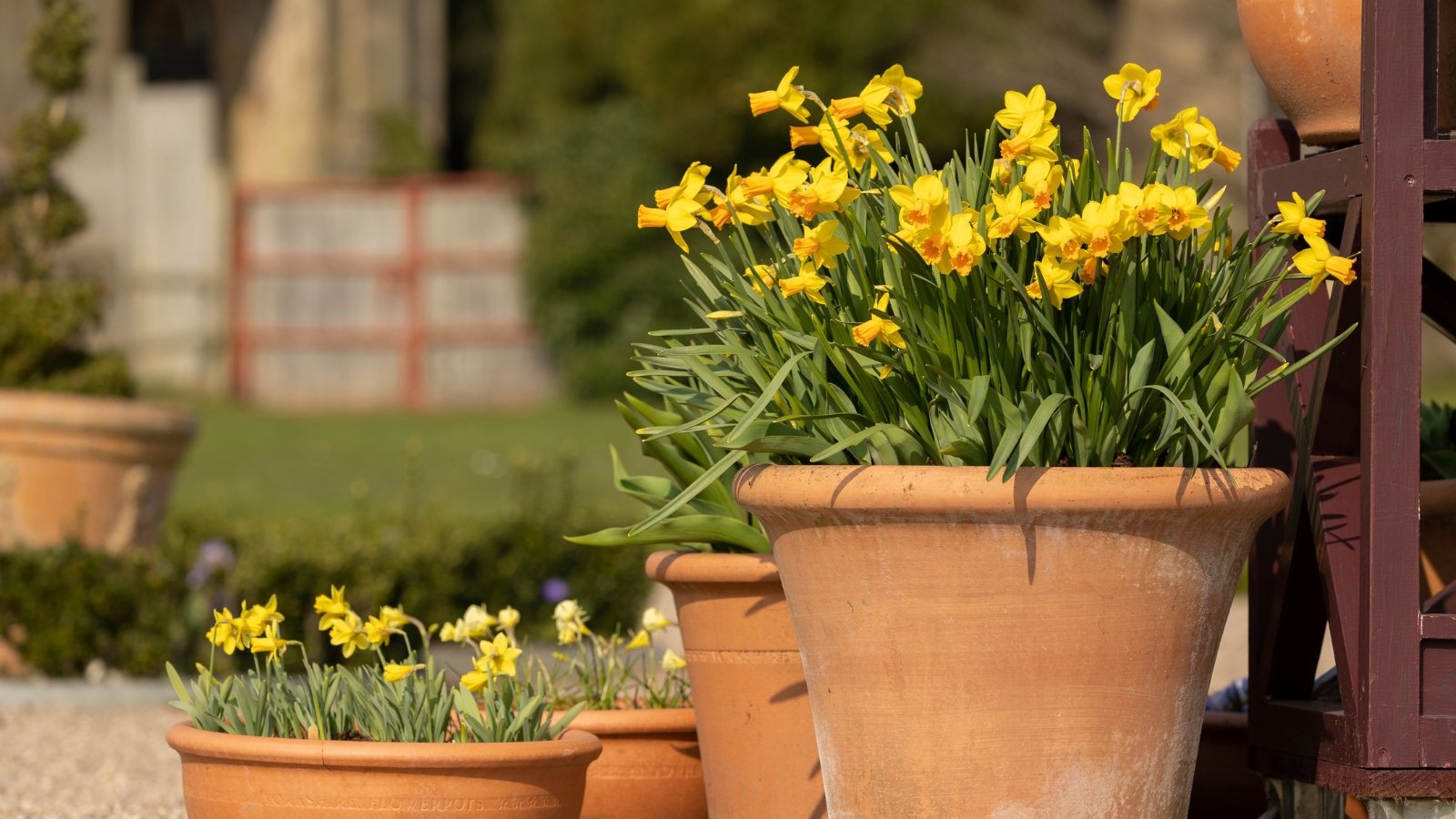
Daffodils’ cheery blooms make the most impact in a group or mass. These little daffodils in a collection give a burst of spring sunshine, offering high color even when not in a garden bed.
Daffodils, with their crisp petals and ruffled cups on slender stems, herald the season’s arrival. In hardiness zones 3-8, Narcissus are carefree growers that perennialize in the right conditions, producing new bulbs for years.
‘Tete-a-tete’ is a beloved early-season daffodil with buttery yellow cups and multiple blooms per stem. It’s one of the first to flower, and the RHS’ Award of Garden Merit winner is a sturdy, floriferous dwarf variety. ‘Yellow Sailboat’ grows 10 to 12 inches tall with reflexed petals that “sail” on the breeze.
‘Golden Dawn’ is taller at 12 to 14 inches, well-suited to adding to a collection of minis. Blooms have a delicate perfume and vivid orange trumpets. To give more height and prolific flowers, ‘Classic Garden’ has orange cups on tall stems that reach 16 to 20 inches.
Layered Classic Trio
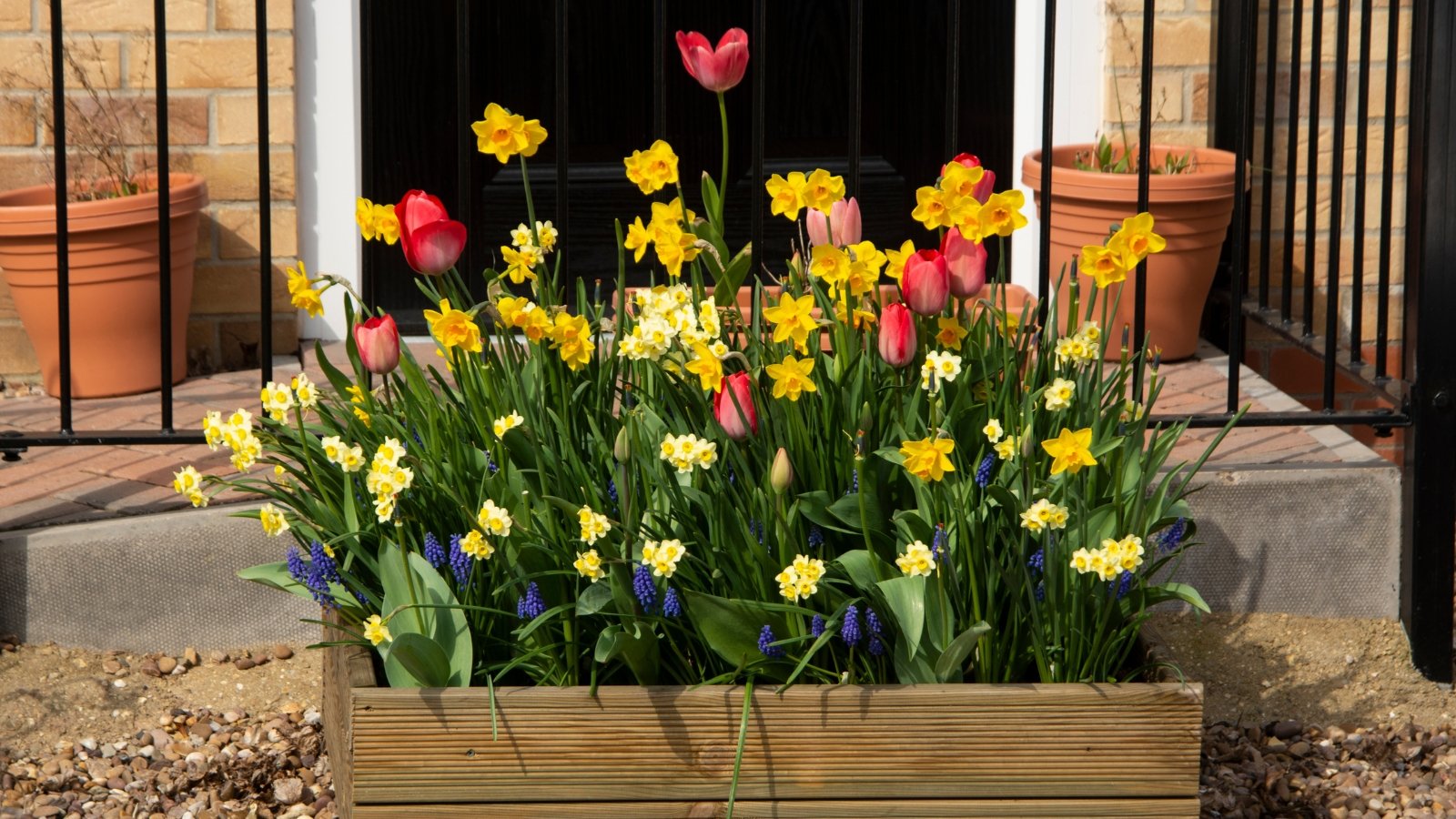
For an abundant look that showcases spring’s offerings, it’s hard to beat a full planting of varied bulbs. The key is to repeat each selection in numbers to unify the look.
Here, grape hyacinth line the front of a planter. Place these small, low-growing bulbs near the edge or outer rim. Hyacinth makes a good edge feature, too, and packs a sweet perfume. Look to Hyacinthus ‘Blue Jacket’ for dense, royal purple-blue flowers on one-foot stalks.
Clusters of small, creamy white daffodils emerge behind the grape hyacinths and contrast with the tall golden daffs. The tall daffodils and red tulips become the “thrillers” in this arrangement, adding color and vertical interest. As more tulips emerge, the spring scene becomes complete.
A stacked bulb planting is easy to achieve by layering the bulbs. Be sure to coordinate the bloom times so there’s overlap. If you have space in the pot, stagger flowering time so a fresh round appears as others fade. Intermingle the bulbs for a naturalistic display (saving the shortest for the perimeter).
Single Tulip Show
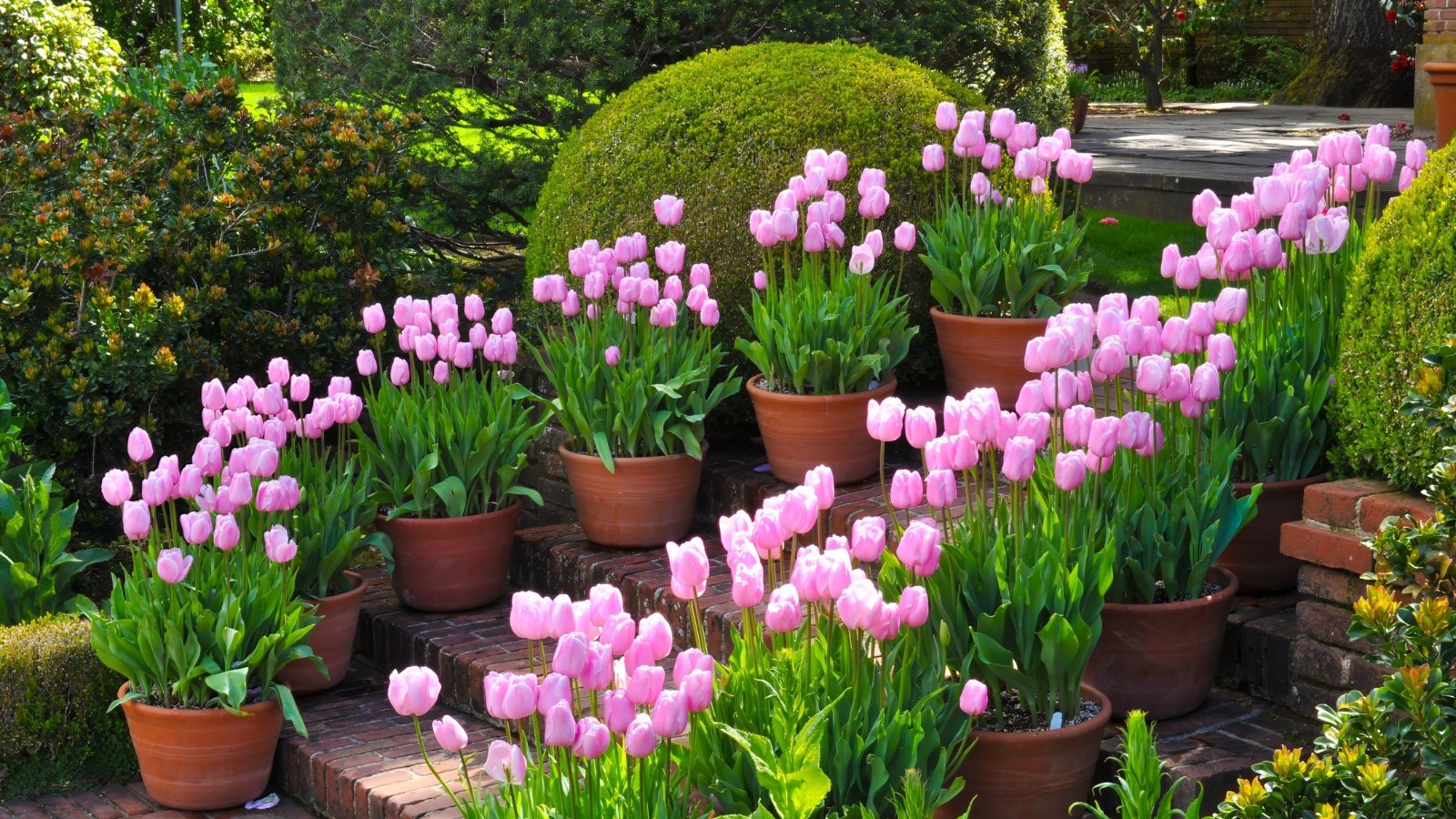
Pink tulips are a fresh classic, from the palest baby pink to pure bubblegum. But any single-color specimen in a group brightens the welcome. Sunny yellow and bright red add vibrance, while creamy white makes the composition more formal.
The more tulips, the better, but even a single pot, or a few, conveys the same idea as these stair-stepped beauties. Just be sure to fill containers with plentiful bulbs for fullness.
Tulips also make a stunning pairing, and complimentary duos blooming together bring an exciting twist. Keep it cohesive by repeating bunches of the same pair.
Darwin hybrids are reliable bloomers across climates, with the most potential to perennialize. The oversized flowers feature perfectly cupped petals and a long bloom time. ‘Pink Impression’ is pure pink, while ‘Apricot Beauty’ blends warm peach and light pink.
Cool Season Annual Combination
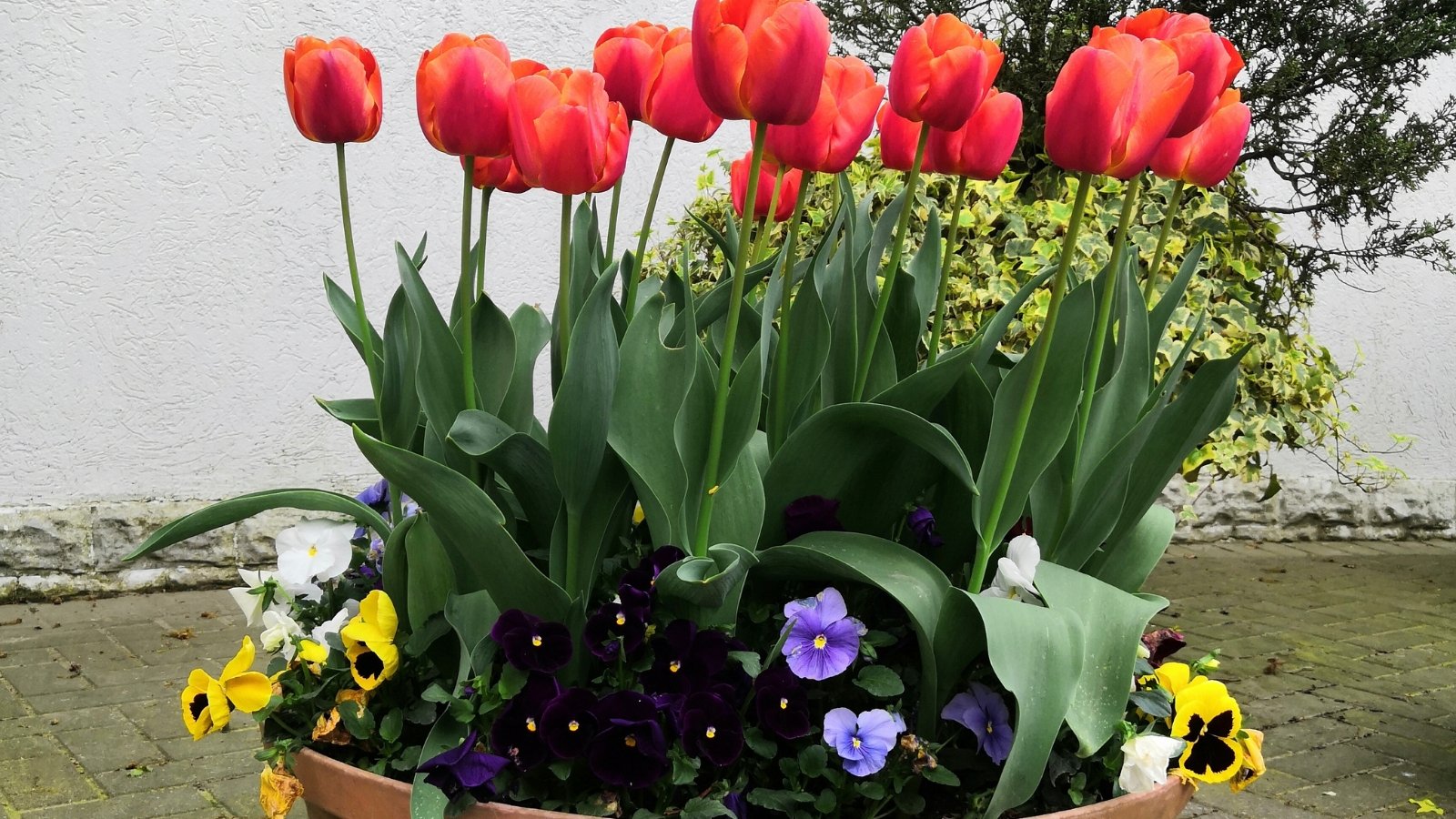
Cool season annuals like pansies, violas, snapdragons, ornamental kale, and other leafy greens blend in a gorgeous combination. When planting your annuals, underplant with bulbs for a total transformation in early spring. When the bulbs fade, pluck or clip them back to continue enjoying the annuals.
Here, coral-red tulips light up a cushion of pansies. Tulipa ‘Orange Cassini’ brings glowing copper edges to coral-red petals. ‘Ile de France’ features tall stems with perfect forms in bright, velvety red with a yellow base. ‘Red Impression,’ a Darwin hybrid, is rich red with light shades on the outer petals.
Spring Deconstructed
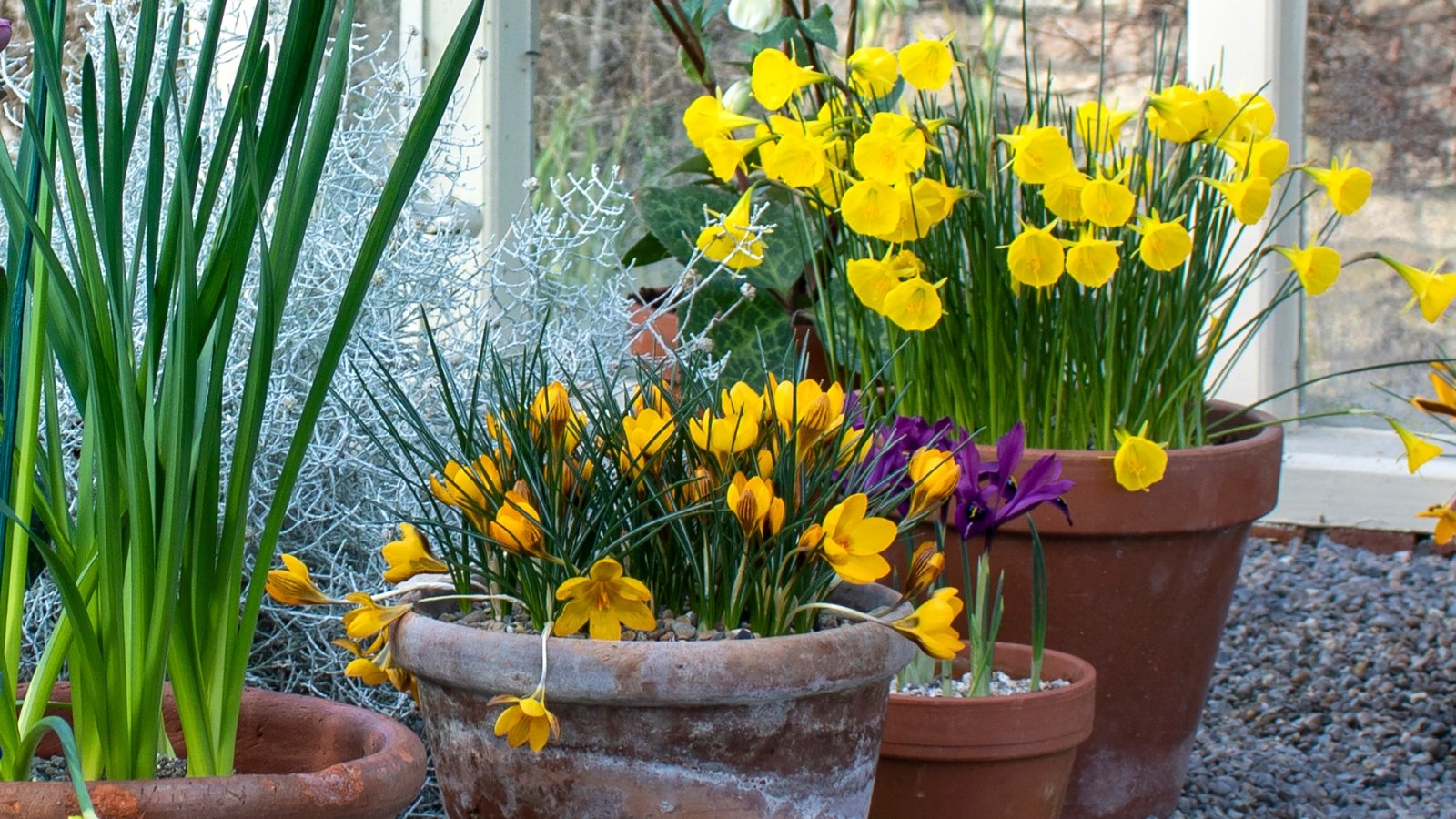
The pretty assortment distills each specimen in a size-matched pot. Tall and mid-sized yellow daffodils flank dwarf irises and deep gold crocus.
Iris reticulata, native to Iran and Turkey, is a dwarf species reaching only about six inches tall. ‘Blue Note’ has deep purple-blue petals with near-black tips. ‘Harmony’ in violet offers a striking contrast to golds and pastels.
For a sweet native dwarf iris, look to Iris cristata, or dwarf crested iris. It has purple-blue petals with white and yellow markings. Out of the pot, it yields a wash of blue as a woodland groundcover. Green, sword-shaped leaves are attractive even when not in flower.
Crocus brings a lot of joy in a small package. Fine blades hold cupped blooms that pop up early, opening by day and closing at night. Colors range from lilac to white to gold to deep violet with contrasting centers. Crocus chrysanthus ‘Romance’ has sunny flowers on four to six-inch stems.
Hellebore adds height (in the background, here) with crisp white flowers. The handsome bulbous perennials have decorative, nodding blooms and dark green palmate leaves. Helleborus spp. bloom in late winter and early spring with exquisite single or double flowers. ‘Molly’s White’ has creamy white blossoms with mossy green centers that rise on purple-brown stems. Silvery veins line the dark leaves.
Rustic Forced Daffodils
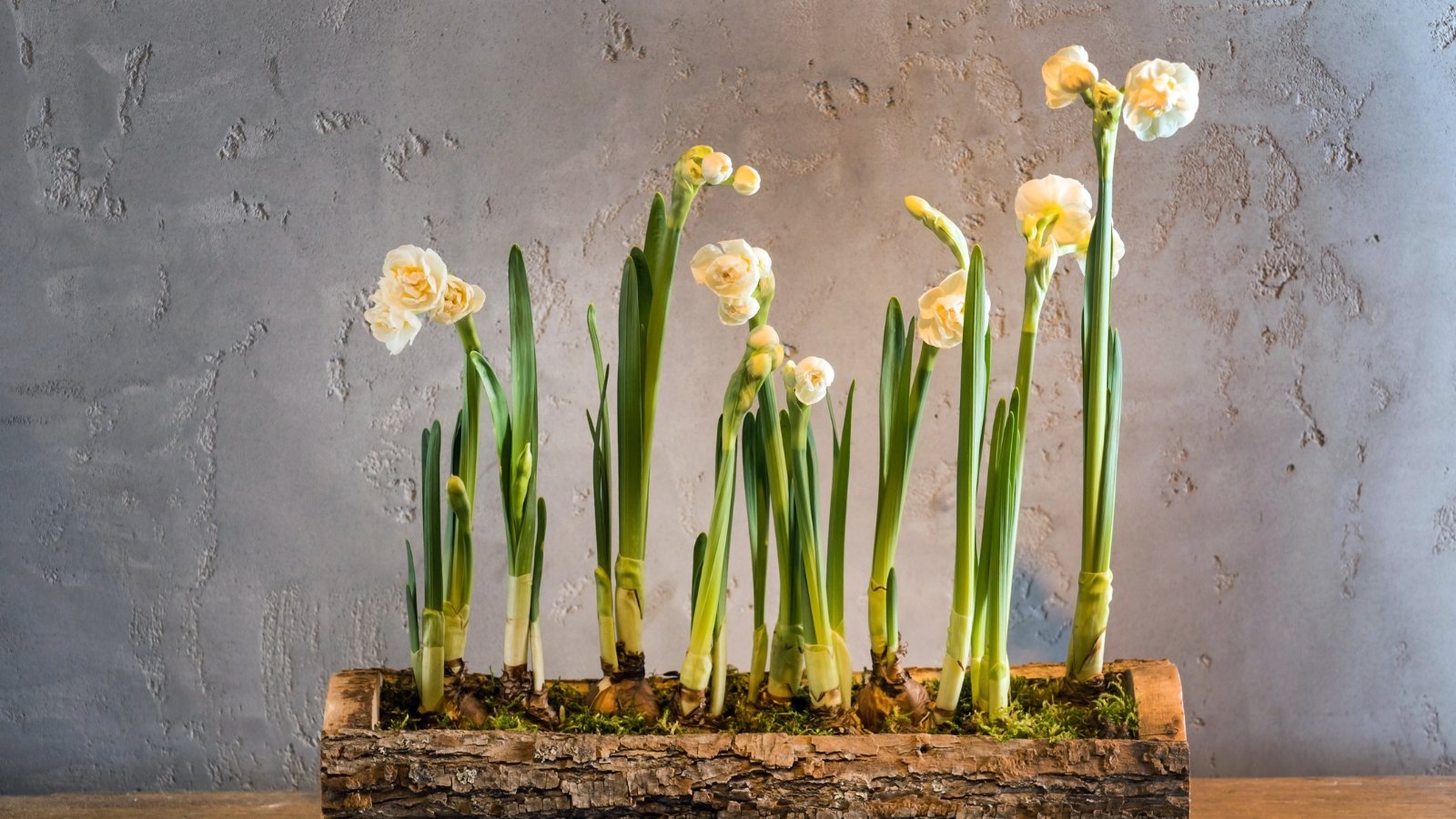
Enjoy Narcissus indoors before temperatures warm by forcing bulbs. This novel twist on potted bulbs combines naturalistic design elements with a contemporary style of a single row of blooms.
Forced bulbs root in a variety of vessels, from a shallow dish of pebbles and water to a bulb vase to, here, a shallow log planter. For paperwhites and daffodils, the base of the bulbs needs contact with water or moist soil to root. Use moss to soften and conceal the media.
Make sure bulbs are pre-chilled if they require vernalization, either from the grower or from time in the refrigerator. Once new growth appears, move them to a warmer, brighter spot to initiate budding.
Unexpected Crown Imperials
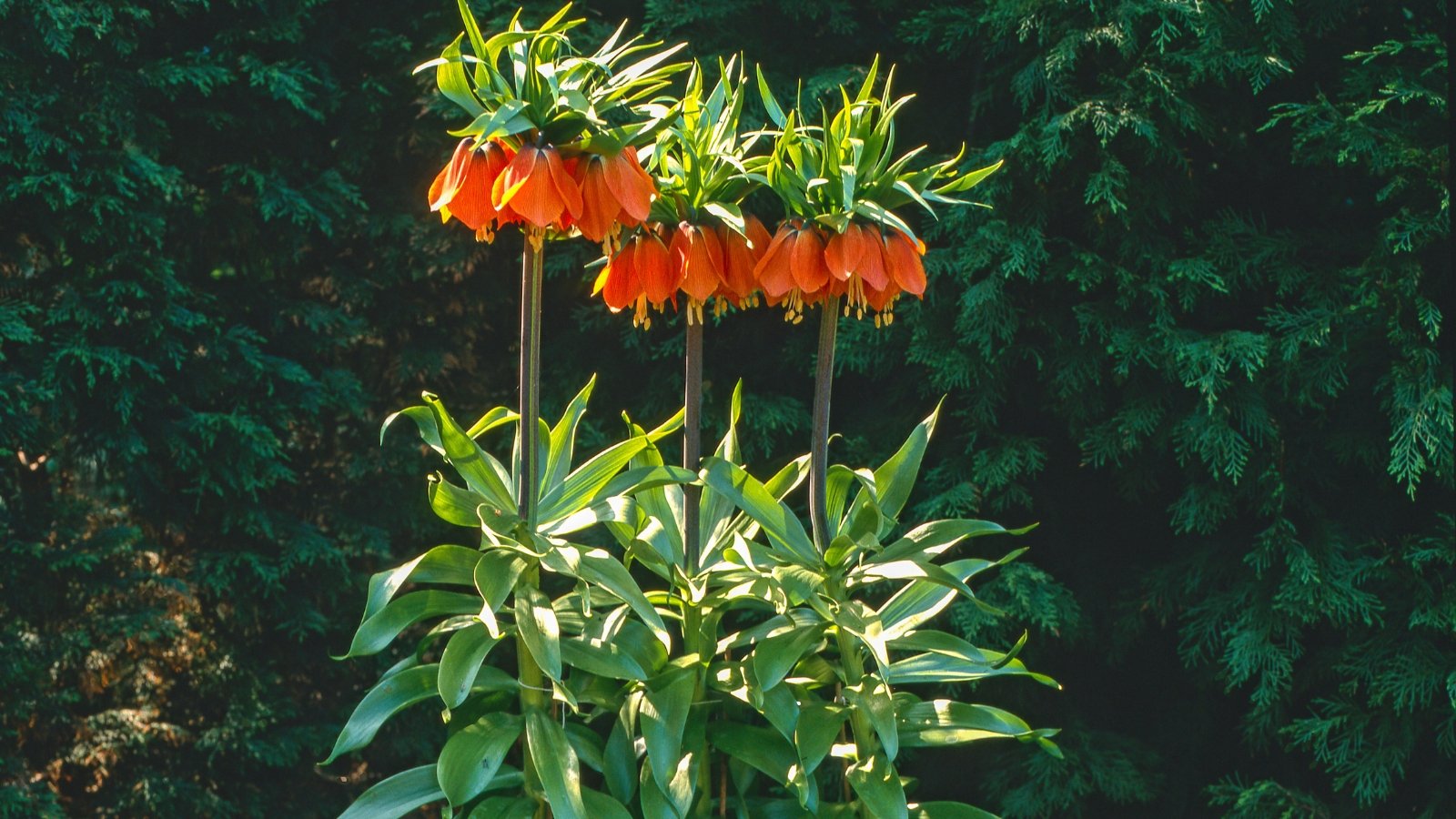
Fritillaria is a little-used perennial, and a favorite among the genus is crown imperial, with cultivars in yellow, orange, and red. The drooping blooms rise on tall, sturdy stems with a flared, leafy crown in glossy green. ‘Rubra Maxima’ has vibrant red-orange flowers and a long bloom time. This tropical-inspired look employs a foundation of rich blue violas for contrast.
With entirely different forms and pendulous cups, North American native species like F. affinis and F. biflora make unique wildflower and naturalized planting additions.
Early to Bloom
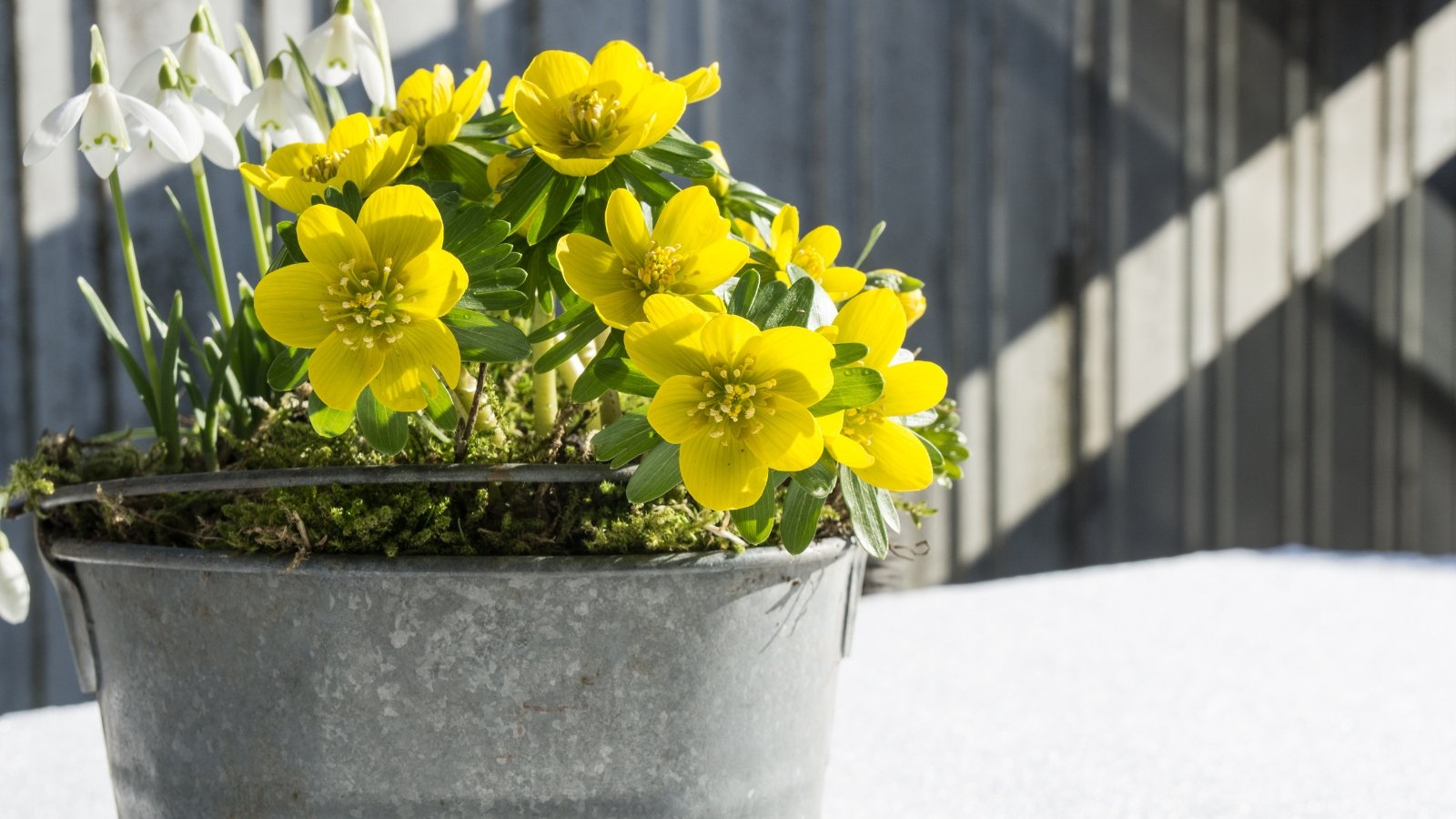
Among the first to pop up through the snow, winter aconite (Eranthis hyemalis) develops from tubers and has bright yellow buttercup flowers on low stems. It makes the most significant impact when closely planted (two inches apart and three inches deep).
Snowdrops have delicate white bell-shaped blooms and a light, fresh perfume to the late winter landscape. Often appearing through frosty ground, snowdrops bloom as early as January. Snuggle them in the pot, a little deeper than winter aconite at four inches.
‘Viridi-apice’ is a snowdrop variety with green tips to its white inner petals and green blotches on its outer petals. It brings a fresh look and a more robust habit than the species.
Architectural Globes

Alliums are a fun, structural addition that stands out in a crowd. Their dramatic flower clusters rise in spring and early summer. Purple, pink, mauve, and white globes top tall stems above long, strappy, blue-green leaves. After flowering, the petals dry and tan for lasting interest into summer.
As ornamental onions bloom, their foliage fades. Aesthetically, it helps to conceal the foliage with other plants. Use low, full annuals as a screen for yellowing leaves. If you don’t plan on growing the bulbs for another year, remove the leaves. To overwinter the perennials, let the foliage stay in place until it browns to continue nutrient storage.
Bloom sizes range from small to huge in alliums. ‘Globemaster’ is a hallmark of giant ornamental alliums with spheres of purple florets that measure 10 inches across. Densely-packed deep lavender florets have a silvery sheen. As each fades, a new floret replaces it for an extended bloom time. The top performer is an RHS Award of Garden Merit recipient.
‘Powder Puff’ features the high ornament of purple-floret spheres in a more compact, cold-hardy form. This ornamental onion bears deep purple, tennis-ball-sized blooms on 14 to 18-inch stems.
Allium ‘Purple Sensation’ is popular for its velvety royal purple four- to five-inch spheres that last for weeks of color. This is one of the earliest blooming of the large-flowered varieties, and with a compact form. Stems reach two to three feet tall.
Holiday Amaryllis
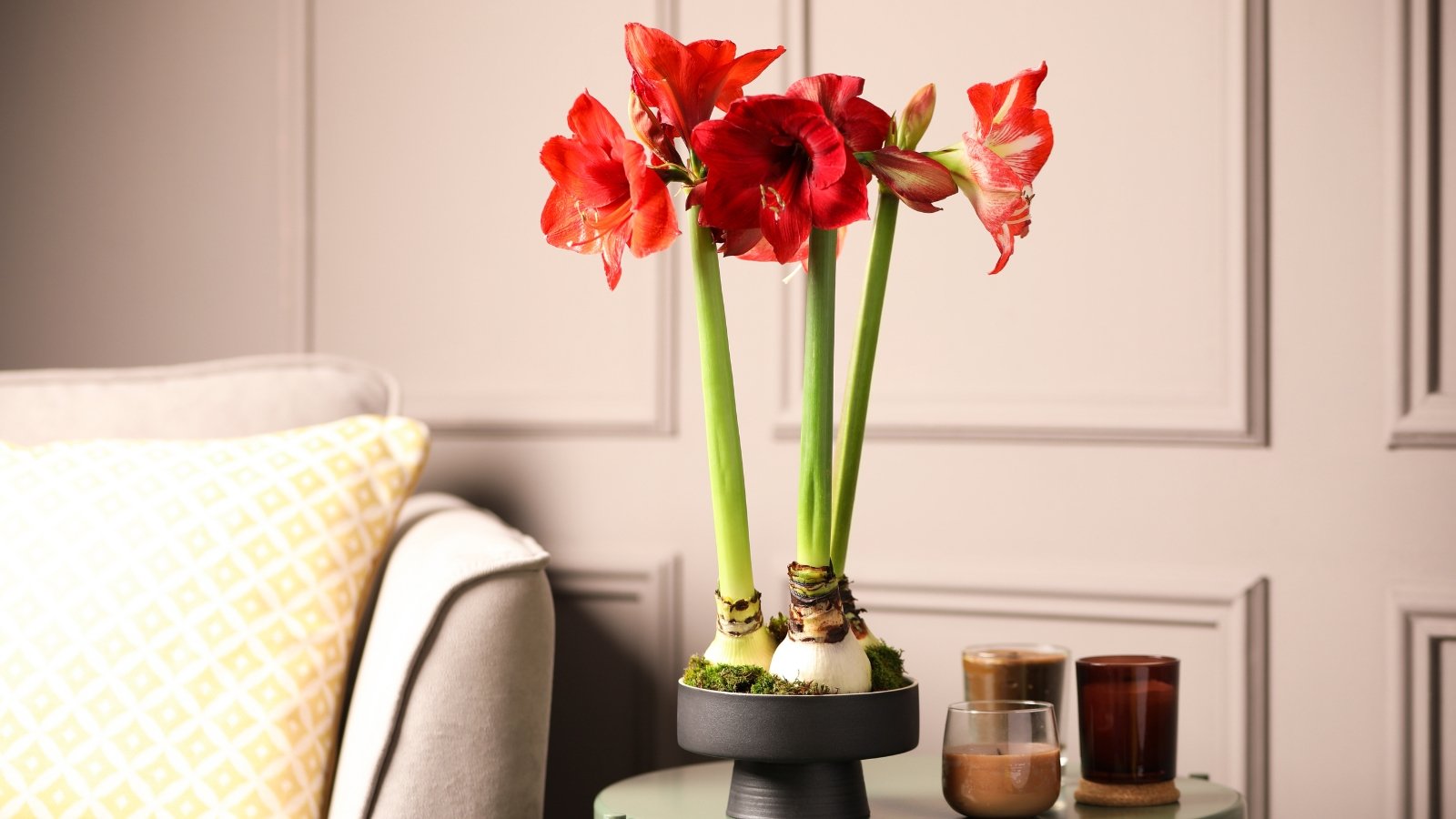
Amaryllis makes a bold, beautiful statement during the holidays. Amaryllis bulbs this time of year are pre-chilled and ready to produce new leaves and blooms quickly – within four to six weeks of planting in the right conditions.
Plant amaryllis with ⅓ of the bulb exposed above the soil line. Use a container one inch larger than the bulb – amaryllis likes to be a little crowded in the pot. Make sure the pot and soil mix have good drainage. You can also grow the bulbs in water in a jar or dish; just make sure only the bottom end (root area) of the bulb is submerged to prevent rot. Adding gravel can help situate the bulb.
Amaryllis blooms once annually, and while we associate them with the holidays, their natural bloom time is in late spring to early summer. In zones 8-10, amaryllis grows in the ground year-round.
Hippeastrum ‘Red Lion’ is a large-flowering variety in crimson. It brings months of color with multiple blooms per stem. ‘Apple Blossom’ is a lovely pink, ‘White Christmas’ is pure white, and ‘Candy Cane’ has striped petals of red and white – just to name a few.




